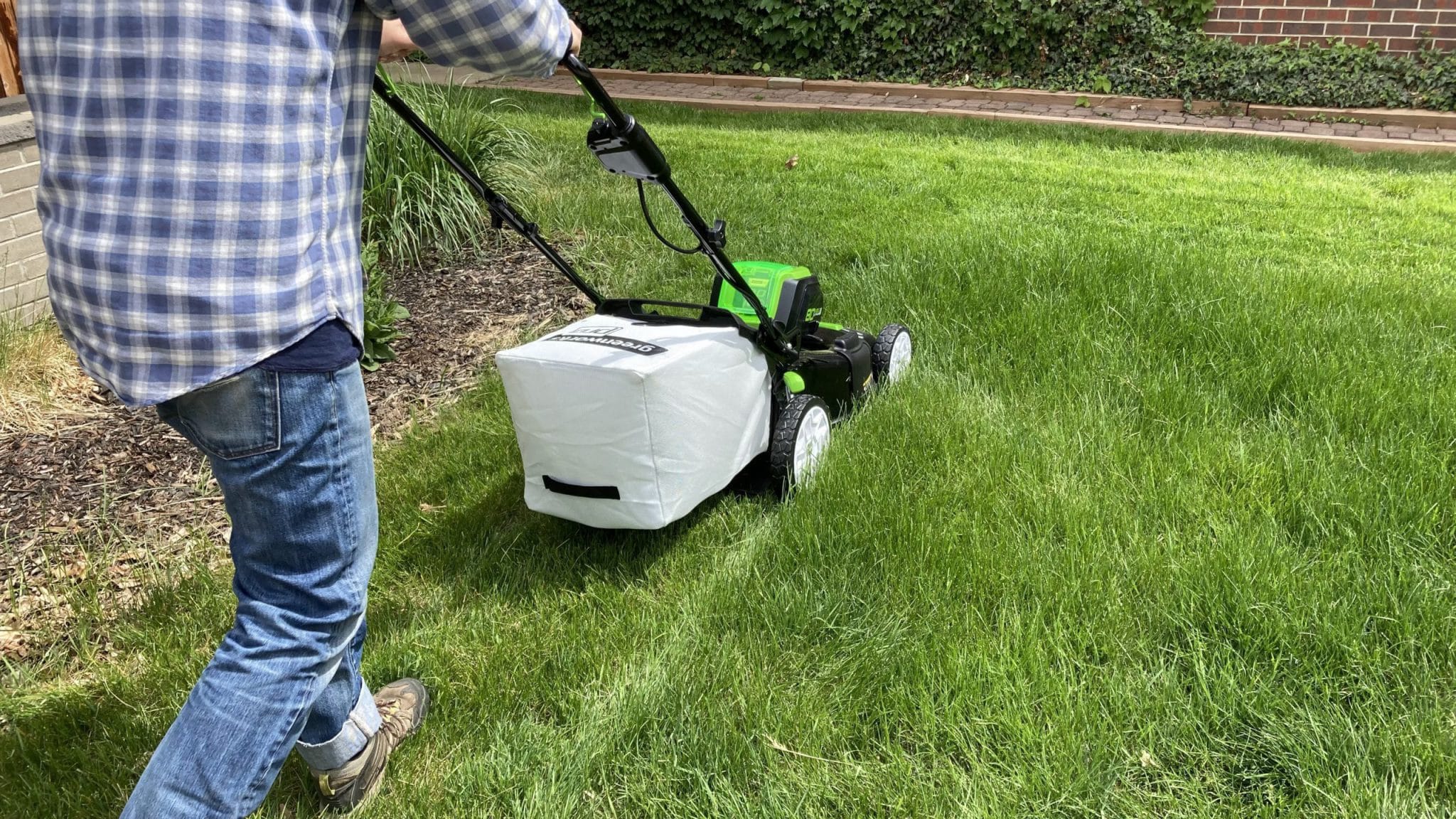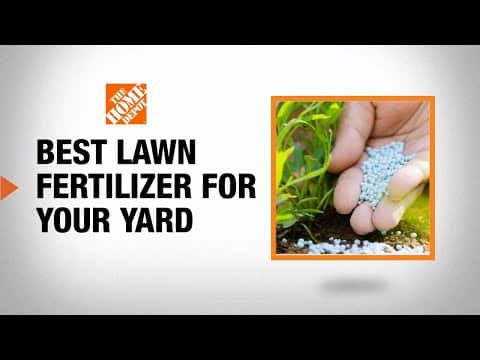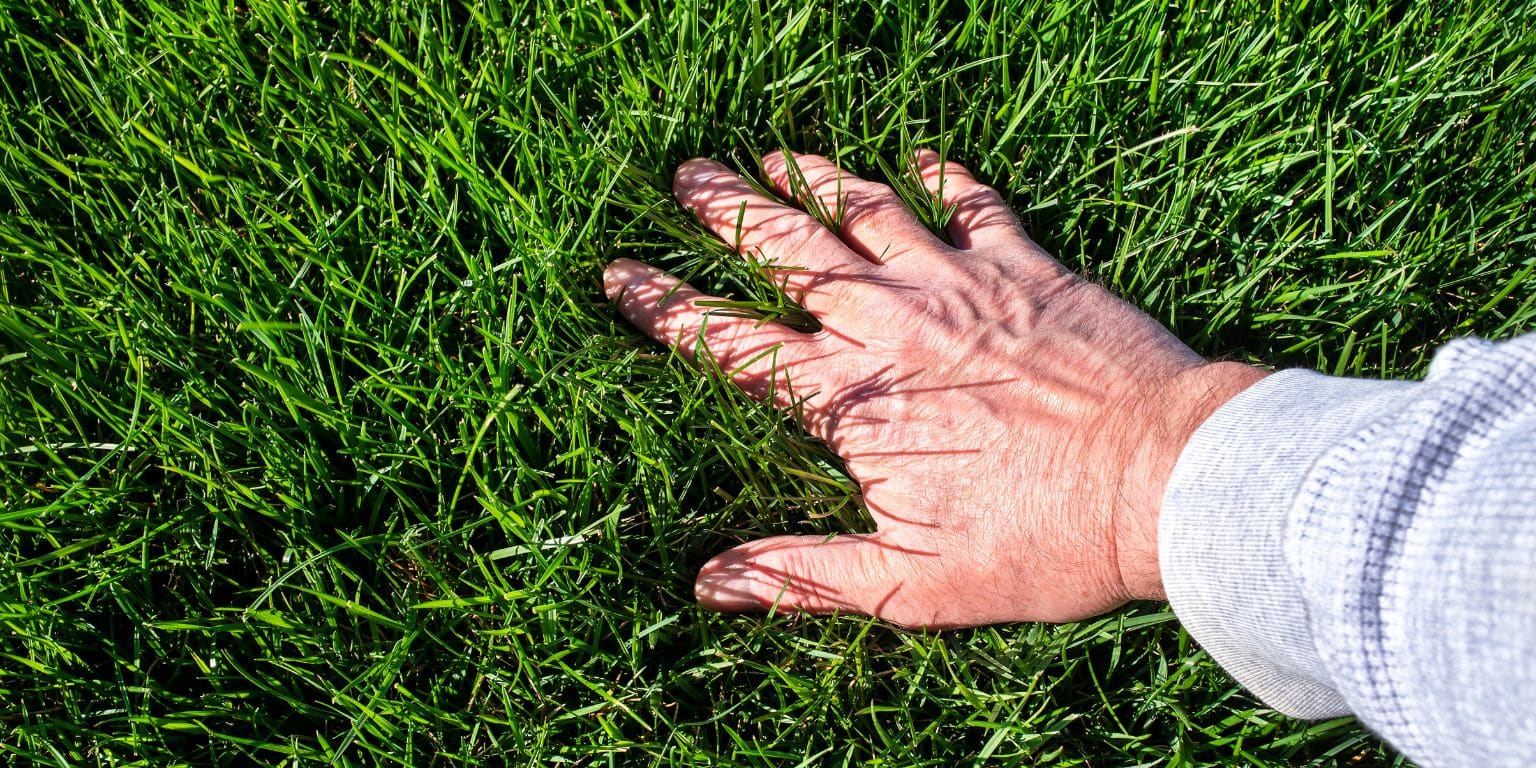Your lawn mower may not be picking up clippings due to a clogged discharge chute or dull mower blades. One possible solution is to clear any debris from the chute and sharpen the blades to improve cutting performance. (Lawn Mower Not Picking Up Clippings)

Table of Contents
ToggleCommon Causes
Is your lawn mower struggling to pick up clippings? It can be frustrating when your mower leaves behind a messy trail of grass after each pass. Fortunately, there are common causes that you can identify and fix to ensure your mower picks up clippings effectively. In this article, we will explore these common causes in detail.
Dull Or Damaged Mower Blades
One of the primary reasons why your lawn mower may not be picking up clippings is due to dull or damaged mower blades. Over time, the blades on your mower can become worn out, resulting in a less effective cutting action. Dull blades tear the grass instead of cleanly cutting it, leaving behind longer clippings that your mower may struggle to collect.

To determine if your mower blades are dull or damaged, you can inspect them visually. Look for nicks, chips, or signs of wear on the cutting edges. If you notice any of these issues, it may be time to sharpen or replace your blades. By maintaining sharp blades, you can ensure a clean and efficient cut, allowing your mower to pick up the clippings with ease.
Clogged Mower Deck
Another common cause of your mower not picking up clippings is a clogged mower deck. As you mow your lawn, grass clippings can accumulate and build up in the deck, reducing its cutting and collecting efficiency. A clogged deck may prevent the clippings from being properly discharged into the bag or mulching system, causing them to be left scattered on the lawn.

To address this issue, it is important to regularly clean and clear the mower deck. Start by disconnecting the spark plug to ensure safety during the process. Use a brush or a hose to remove any debris, grass clippings, or other materials that may be obstructing the deck. Check the discharge chute for any clogs and clear them if necessary. By keeping the mower deck clean and free from debris, you can maximize the effectiveness of your mower’s clippings collection.
Incorrect Cutting Height
The cutting height of your lawn mower plays a crucial role in its ability to pick up clippings effectively. Mowing with a cutting height that is too low can result in clippings getting packed tightly into the grass, making it difficult for the mower to collect them. On the other hand, mowing with a cutting height that is too high may leave behind excessively long clippings that are challenging to gather.

To ensure your mower is cutting at the optimal height, refer to the manufacturer’s guidelines or adjust it to a height suitable for your grass type. It is generally recommended to remove no more than one-third of the grass height at a time. By mowing at the correct height, you can promote a cleaner cut and facilitate the collection of clippings by your mower.
By addressing these common causes, you can troubleshoot and resolve the issue of your lawn mower not picking up clippings effectively. By keeping your mower blades sharp, clearing any clogs in the deck, and mowing at the proper cutting height, you can achieve a well-maintained lawn free from messy clippings.
Checking And Sharpening Blades

When your lawn mower is not picking up clippings, one possible solution is to check and sharpen the blades. Sharp blades ensure a clean cut, helping the mower to effectively collect the clippings and leave your lawn looking pristine.
Removing And Inspecting The Blades
When it comes to your lawn mower not picking up clippings, one of the first things you should check is the condition of the blades. Over time, blades can become dull or even damaged, preventing effective grass cutting and collecting. Fortunately, checking and sharpening the blades is a fairly simple task that can be done with just a few basic tools.
- Start by switching off the lawn mower and unplugging it for safety.
- Locate the blade on the underside of the mower deck. Often, it is held in place with a few bolts or screws.
- Using a socket wrench or the appropriate tool, carefully remove the bolts or screws that secure the blade.
- Once the blade is free, inspect it for any signs of damage, such as chips, cracks, or excessive wear. If there are any issues, this may indicate a need for a replacement blade.
- Carefully inspect the blade for any debris or grass clippings that may be stuck. Use a brush or a soft cloth to clean the blade thoroughly.
- After inspecting and cleaning the blade, it’s crucial to check its balance. An imbalanced blade can cause vibration that may damage the lawn mower or affect its performance. There are tools available, like a blade balancer, to check the balance accurately.
- Once you’ve completed the inspection and cleaning, it’s time to reattach the blade. Align the blade carefully and secure it back in place using the bolt or screw.
- Give the blade one last check to ensure it is securely fastened and correctly balanced.
Sharpening Or Replacing Dull Blades
If your inspection reveals that the blade is dull, it’s essential to sharpen or replace it to restore your lawn mower’s efficiency. Dull blades can tear the grass rather than cleanly cutting it, resulting in clippings that are not effectively picked up.
- Remove the blade following the steps mentioned above.
- Secure the blade in a vise or a bench clamp, making sure it is stable and won’t move during sharpening.
- Using a file or a grinder, carefully sharpen the blade at the original cutting angle. Work uniformly across the cutting edge, ensuring you maintain a consistent angle along the length of the blade.
- As you sharpen, periodically check the blade’s balance using a blade balancer.
- Once the blade is sharp and balanced, reinstall it on the lawn mower following the previous steps.
If the blade is severely damaged or cannot be adequately sharpened, it’s time to consider a replacement. You can purchase a new blade from the manufacturer, a local hardware store, or an online retailer. Be sure to choose a blade that is compatible with your specific lawn mower model.
By regularly checking and sharpening or replacing your lawn mower blades, you can ensure optimal performance and an evenly cut lawn. Remember to follow all safety precautions and consult your lawn mower’s manual if you need additional guidance.
Clearing Clogged Mower Deck
One common issue that many lawn mower owners face is when their mower is not picking up clippings. This can be frustrating, as it can leave behind a messy lawn and require extra clean-up afterward. One of the main reasons for this problem is a clogged mower deck. A clogged mower deck can occur due to debris, grass clumps, or a build-up of dirt and grass. In this section, we will explore some simple steps to clear a clogged mower deck so that your mower can pick up clippings efficiently again.
Removing Debris From The Deck

When your lawn mower’s deck is clogged, the first step is to remove any debris that may be blocking the path of the clippings. Debris such as twigs, leaves, and rocks can accumulate in the mower deck, obstructing its ability to pick up clippings effectively. To remove the debris, follow these steps:
| Step | Procedure |
|---|---|
| 1 | Disconnect the spark plug to ensure the mower is not accidentally started. |
| 2 | Turn the mower on its side, making sure the air filter and carburetor are facing up to prevent any oil or fuel from leaking. |
| 3 | Carefully inspect the underside of the deck for any visible debris. Use a brush, such as a wire brush or a stiff bristle brush, to remove the debris. Make sure to wear protective gloves to avoid any injuries. |
| 4 | After clearing the debris, use a hose or pressure washer to clean the deck thoroughly. This will help remove any dirt or smaller debris that may still be stuck. |
| 5 | Allow the mower deck to dry completely before reassembling and reattaching the spark plug. |
Cleaning The Chute Area
Another area that can cause a clogged mower deck is the chute area, where the clippings are expelled. A blocked or dirty chute can restrict the flow of clippings, resulting in clippings not being picked up properly. To clean the chute area, follow these steps:
- First, disconnect the spark plug to prevent any accidental starts.
- Locate the chute area, which is usually at the rear or side of the mower’s deck.
- Inspect the chute area for any visible debris or grass clumps. Remove any obstructions using a gloved hand or a stick.
- If the chute is dirty or caked with grass, use a brush or cloth to wipe it clean. You may also use a hose to spray water through the chute to wash away any remaining debris.
- Allow the chute area to dry thoroughly before reconnecting the spark plug and using the mower again.
Removing Grass Clumps
Grass clumps can also be a common cause of a clogged mower deck. When grass clumps accumulate in the deck, they can prevent the blades from spinning properly and picking up clippings. To remove grass clumps, follow these steps:
| Step | Action |
|---|---|
| 1. | Disconnect the spark plug to ensure the mower is not accidentally started. |
| 2. | Examine the underside of the deck for any visible grass clumps. |
| 3. | Using a gloved hand or a stick, break up the grass clumps and remove them from the deck. |
| 4. | Clean the deck using a hose or pressure washer to rinse away any remaining grass clippings or debris. |
| 5. | Allow the mower deck to dry thoroughly before reattaching the spark plug and resuming mowing. |
By following these simple steps to clear a clogged mower deck, you can ensure that your lawn mower is picking up clippings efficiently and leaving behind a well-maintained lawn. Regular maintenance and cleaning of the mower deck will prevent future clogs and keep your lawn looking its best.
Adjusting Cutting Height
Adjusting the cutting height of your lawn mower is crucial when it comes to achieving a clean and tidy lawn. If you find that your mower is not picking up clippings effectively, it may be because the cutting height is not set correctly. In this section, we will explore the importance of understanding the ideal cutting height for your grass type and how to adjust the mower deck height accordingly.
Understanding The Ideal Cutting Height For Your Grass Type
Before you can adjust your mower’s cutting height, it’s important to understand the ideal cutting height for your specific grass type. Different grasses have different requirements, and cutting them too short or leaving them too long can affect their health and appearance.
Here are some common grass types and their recommended cutting heights:
| Grass Type | Ideal Cutting Height (inches) |
|---|---|
| Bermuda Grass | 0.5 – 1.5 |
| Zoysia Grass | 1 – 2 |
| Fescue Grass | 2 – 3.5 |
| St. Augustine Grass | 2.5 – 4 |
Keep in mind that these are general guidelines, and it’s always a good idea to consult with a lawn care professional or refer to your grass type’s specific maintenance recommendations for the most accurate cutting height.
Adjusting The Mower Deck Height Accordingly
Now that you have a clear understanding of the ideal cutting height for your grass type, it’s time to adjust the height of your mower deck. The deck height refers to the distance between the ground and the bottom of the mower’s cutting blade.
Follow these steps to adjust the cutting height:
- Park your lawn mower on a flat surface and make sure the engine is turned off.
- Locate the adjustment levers or knobs on your mower deck. These are usually located on either side or at the front of the deck.
- Refer to your mower’s user manual to determine which direction increases or decreases the cutting height.
- Using your user manual as a guide, adjust the cutting height by moving the levers or knobs to the desired setting.
- Ensure that both sides of the mower deck are set to the same height to achieve an even cut.
Once you have adjusted the cutting height to the appropriate settings for your grass type, you can proceed to mow your lawn. Remember to make gradual adjustments if you need to change the cutting height, as drastic changes can stress the grass and lead to uneven cutting or damage.
By understanding the ideal cutting height for your grass type and adjusting your mower deck accordingly, you can ensure a clean and healthy lawn that is free from clippings and looks its best.
Additional Tips
When it comes to mowing your lawn, it can be frustrating to find that your mower is not picking up clippings as efficiently as it should. Luckily, there are a few additional tips that can help improve the performance of your mower and ensure a clean and manicured lawn. Taking the time to check the condition of the grass for excessive moisture, keeping the lawn clean of debris before mowing, and regularly maintaining and cleaning the mower are key steps to resolving this issue.
Checking The Condition Of The Grass For Excessive Moisture
If you find that your mower is not picking up clippings effectively, one possible cause could be excessive moisture in the grass. Wet or damp grass tends to clump together, making it challenging for the mower to properly collect the clippings. To overcome this issue, it’s important to inspect the condition of the grass before mowing. Here’s what you can do:
- Walk on the lawn and feel the grass with your hand. If it feels excessively wet, it’s best to wait until the grass dries out a bit before mowing.
- Consider mowing in the late morning or afternoon when the morning dew has had a chance to evaporate.
- Opt for a higher cutting height to prevent the mower from bogging down in wet clumps of grass.
Keeping The Lawn Clean Of Debris Before Mowing
Another factor that can affect your mower’s ability to pick up clippings is a lawn filled with debris. Before you start mowing, take the time to clear the area of any branches, twigs, rocks, or other obstacles. Here are some tips to keep your lawn debris-free:
- Walk around the yard to identify any debris and remove it by hand or using a rake.
- Ensure that the cutting deck and discharge chute of your mower are free from obstructions.
- If you have a large yard with heavy debris, consider using a leaf blower or a lawn sweeper to clear the area more efficiently.
Regular Maintenance And Cleaning Of The Mower
Maintaining and cleaning your mower regularly is crucial for optimal performance and picking up clippings effectively. Here are some maintenance tips to keep in mind:
- Sharpen the mower blades regularly to ensure a clean cut, which allows the clippings to be lifted more efficiently.
- Keep the underside of the mower clean by removing any built-up grass clippings and debris. A clean cutting deck promotes better airflow and collection of clippings.
- Check and replace the air filter, oil, and spark plug as recommended by the mower manufacturer to keep the engine running smoothly.
By following these additional tips, you can overcome the issue of your mower not picking up clippings effectively. Remember to check the condition of the grass for excessive moisture, keep the lawn clean of debris before mowing, and regularly maintain and clean your mower. With these steps in place, you’ll be able to achieve a beautifully manicured lawn with ease.
Regular maintenance and cleaning of your mower is crucial for keeping your lawn equipment in top-notch condition. Wondering how to clean mowers effectively? Well, it starts with a comprehensive approach. Begin by checking your mower’s maintenance checklist regularly, ensuring you cover essential tasks like blade sharpening, oil changes, and air filter replacements.
For push mowers, pay close attention to the mower deck—clean out accumulated grass clippings and debris to prevent rust and ensure optimal performance. The same goes for the mower blade; regular sharpening enhances cutting efficiency. Whether you have a traditional lawn mower, a flymo, a zero-turn, or a riding mower, the key is consistent care.
Safety is paramount when dealing with lawn mowers. Prioritize the four safety essentials: proper clothing, eye protection, awareness of surroundings, and following the manufacturer’s guidelines. For electric lawn mowers, keep an eye on the battery and cables. And if you’re ever unsure, consider professional lawn mower maintenance services near you for expert assistance. Remember, a well-maintained mower not only ensures a manicured lawn but also prolongs the lifespan of your valuable equipment.
Frequently Asked Questions Of Lawn Mower Not Picking Up Clippings
Why Does My Mower Leave So Many Grass Clippings?
Your mower may leave excessive grass clippings due to a few reasons. It is possible that the mower blade is dull and needs sharpening. Cutting the grass too short can cause larger clippings. Mowing wet grass can also result in clumps of clippings.
Ensure your mower blade is sharp, cut at an appropriate height, and mow dry grass for better results.
Why Aren’t My Grass Clippings Going Into The Bag?
Grass clippings may not be going into the bag because the bag could be full or not properly attached. Check if the bag is empty and securely fastened to ensure clippings are collected.
What Is The Easiest Way To Get Up Grass Clippings?
The easiest way to remove grass clippings is by using a lawn mower with a bag attachment. Simply mow your lawn and collect the clippings in the bag. Afterwards, you can dispose of them as needed.
Why Are My Mulching Blades Not Mulching?
Mulching blades may not be mulching due to dullness, incorrect blade installation, or the wrong type of blades for the mower. Ensure the blades are sharp and properly attached, consult the mower’s manual for the correct blade type, and replace if necessary.
Conclusion
If your lawn mower is not effectively picking up clippings, there are several potential reasons for this issue. From a clogged grass chute to a dull mower blade, addressing these problems will help restore the mower’s functionality. Regular maintenance and proper operation techniques play a crucial role in keeping your lawn mower in top shape.
By implementing these troubleshooting steps, you can ensure a well-manicured lawn and a smoothly running mower.





